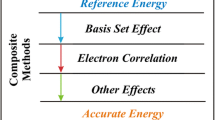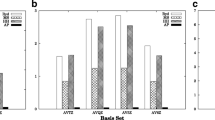Abstract
The G3X-CEP and G3X(CCSD)-CEP composite methods were developed by combining a compact effective pseudopotential (CEP) with the G3X and G3X(CCSD) all-electron methods. The G3/05 test set was used as reference data to analyze the performance of these methods by calculating enthalpies of formation, ionization energies, electron affinities, proton affinities, and molecular atomization energies. Tests were carried out considering different numbers of higher-level correction (HLC) parameters as well as a scaling of the experimental atomization energies of the elements used to determine the enthalpies of formation. The overall behavior of G3X-CEP and G3X(CCSD)-CEP calculations considering six HLC parameters presented a mean absolute error around 1.15 kcal mol−1 for all calculated properties. This tendency is intermediate to the G3CEP and G4CEP methods. The use of scaled experimental atomization energies of the elements provided a mean absolute error around 1.11 kcal mol−1, which is similar to the one obtained by the G4CEP theory (1.09 kcal mol−1). The G3X-CEP and G3X(CCSD)-CEP enthalpies of formation were significantly improved with respect to experimental results. Molecular atomization energies showed a modest improvement, while the ionization energies and electronic affinities were slightly affected indirectly by the reoptimized HLC parameters. The proton affinities were nearly unaffected.
Similar content being viewed by others
References
Curtiss LA, Redfern PC, Raghavachari K, Pople JA (2002) Gaussian-3X (G3X) theory using coupled cluster and Brueckner energies. Chem Phys Lett 359:390–396. https://doi.org/10.1016/S0009-2614(02)00742-X
Curtiss LA, Redfern PC, Raghavachari K (2005) Assessment of Gaussian-3 and density-functional theories on the G3/05 test set of experimental energies. J Chem Phys 123:124107–124118. https://doi.org/10.1063/1.2039080
Pople JA, Head-Gordon M, Fox DJ et al (1989) Gaussian-1 theory: a general procedure for prediction of molecular energies. J Chem Phys 90:5622–5629. https://doi.org/10.1063/1.456415
Curtiss LA, Raghavachari K, Pople JA (1992) Gaussian-2 theory using reduced Moller–Plesset orders. J Chem Phys 98:1293–1298. https://doi.org/10.1063/1.464297
Curtiss LA, Raghavachari K, Redfern PC et al (1998) Gaussian-3 (G3) theory for molecules containing first and second-row atoms. J Chem Phys 109:7764–7776. https://doi.org/10.1063/1.477422
Curtiss LA, Redfern PC, Raghavachari K (2007) Gaussian-4 theory. J Chem Phys 126:084108–084119. https://doi.org/10.1063/1.2436888
Curtiss LA, Redfern PC, Raghavachari K (2011) Gn theory. WIREs Interdiscip Rev Comput Mol Sci 1:810–825. https://doi.org/10.1002/wcms.59
Curtiss LA, Raghavachari K, Redfern PC, Pople JA (2000) Assessment of Gaussian-3 and density functional theories for a larger experimental test set. J Chem Phys 112:7374. https://doi.org/10.1063/1.481336
Dorofeeva OV, Moiseeva NF (2006) Computational study of the thermochemistry of organophosphorus(III) compounds. J Phys Chem A 110:8925–8932. https://doi.org/10.1021/jp060982f
Wang L, Lv G (2010) Prediction of gas-phase thermodynamic properties for polychlorinated naphthalenes using G3X model chemistry and density functional theory. Chemosphere 78:77–85. https://doi.org/10.1016/j.chemosphere.2009.10.041
He Y-L, Wang L (2009) Potential energy surfaces for protonation of hydrochlorofluoromethanes. J Mol Struct THEOCHEM 913:240–246. https://doi.org/10.1016/j.theochem.2009.08.007
Wang L, Liu Y (2010) The enthalpies of formation of brominated benzenes and phenols: A theoretical prediction. J Mol Struct THEOCHEM 957:72–76. https://doi.org/10.1016/j.theochem.2010.07.009
Akhmetova N, Kaliyeva L, O′Reilly RJ (2016) Assessment of quantum chemical methods for the calculation of homolytic N–F bond dissociation energies. Chem Data Collect 5–6:28–35. https://doi.org/10.1016/j.cdc.2016.10.003
Pereira DH, Ramos AF, Morgon NH, Custodio R (2011) Implementation of pseudopotential in the G3 theory for molecules containing first-, second-, and non-transition third-row atoms. J Chem Phys 135:034106–034120. https://doi.org/10.1063/1.3609241
Pereira DH, Ramos AF, Morgon NH, Custodio RR (2011) Erratum: “Implementation of pseudopotential in the G3 theory for molecules containing first-, second-, and non-transition third-row atoms” [J. Chem. Phys. 135, 034106 (2011)]. J Chem Phys 135:219901. https://doi.org/10.1063/1.3666235
Stevens WJ, Basch H, Krauss M (1984) Compact effective potentials and efficient shared-exponent basis sets for the first- and second-row atoms. J Chem Phys 81:6026–6033. https://doi.org/10.1063/1.447604
Stevens WJ, Krauss M, Basch H, Jasien PG (1992) Relativistic compact effective potentials and efficient, shared-exponent basis sets for the third-, fourth-, and fifth-row atoms. Can J Chem 70:612–630. https://doi.org/10.1139/v92-085
Pereira DH, Ducati LC, Rittner R, Custodio R (2014) A study of the rotational barriers for some organic compounds using the G3 and G3CEP theories. J Mol Model 20:2199–2212. https://doi.org/10.1007/s00894-014-2199-3
Rocha CMR, Pereira DH, Morgon NH, Custodio R (2013) Assessment of G3(MP2)//B3 theory including a pseudopotential for molecules containing first-, second-, and third-row representative elements. J Chem Phys 139:184108–184119. https://doi.org/10.1063/1.4826519
Rocha CMR, Rodrigues JAR, Moran PJS, Custodio R (2014) An interpretation of the phenol nitration mechanism in the gas phase using G3(MP2)//B3-CEP theory. J Mol Model 20:2524–2531. https://doi.org/10.1007/s00894-014-2524-x
Pereira DH, Rocha CMR, Morgon NH, Custodio R (2015) G3(MP2)-CEP theory and applications for compounds containing atoms from representative first, second and third row elements of the periodic table. J Mol Model 21:204–210. https://doi.org/10.1007/s00894-015-2757-3
de Silva CS, Pereira DH, Custodio R (2016) G4CEP: A G4 theory modification by including pseudopotential for molecules containing first-, second- and third-row representative elements. J Chem Phys 144:204118–204126. https://doi.org/10.1063/1.4952427
Heerdt G, Pereira DH, Custodio R, Morgon NH (2015) W1CEP theory for computational thermochemistry. Comput Theor Chem 1067:84–92. https://doi.org/10.1016/j.comptc.2015.05.011
Nelder JA, Mead R (1965) A simplex method for function minimization. Comput J 7:308–313. https://doi.org/10.1093/comjnl/7.4.308
Curtiss LA, Raghavachari K, Redfern PC, Pople JA (1997) Assessment of Gaussian-2 and density functional theories for the computation of enthalpies of formation. J Chem Phys 106:1063–1079
Absar I, van Wazer JR (1971) The barrier to internal rotation in monomethylphosphine: an ab initio LCAO-MO-SCF study. J Chem Soc D Chem Commun. https://doi.org/10.1039/c29710000611
Acknowledgements
The authors would like to acknowledge financial support from FAPEAM (Fundação de Amparo à Pesquisa do Estado do Amazonas), FAPESP (Fundação de Amparo à Pesquisa do Estado de São Paulo-Center for Computational Engineering and Sciences, Grants 2013/08293-7 and 2017/11485-6), and FAEPEX-UNICAMP (Fundo de Apoio ao Ensino, à Pesquisa e à Extensão da UNICAMP). The National Center of High Performance Computing in São Paulo (CENAPAD-SP) is acknowledged for access to their computational facilities.
Author information
Authors and Affiliations
Corresponding author
Electronic supplementary material
Below is the link to the electronic supplementary material.
214_2018_2206_MOESM1_ESM.docx
The supplemental file contains truncated basis set (G3large—Table S.1, G3Xlarge—Table S.2), to be used along with the CEP pseudopotential. The file also contains the following calculated data using G3X-CEP, G3(CCSD)-CEP, EnAt1, and EnAt2 theories: enthalpies of formation—Table S.3, ionization energies—Table S.4, electron affinities—Table S.5, proton affinities—Table S.6, and atomization energies—Table S.7. (DOCX 111 kb)
Rights and permissions
About this article
Cite this article
Silva, C.S., Custodio, R. Empirical corrections in the G3X and G3X(CCSD) theories combined with a compact effective pseudopotential. Theor Chem Acc 137, 24 (2018). https://doi.org/10.1007/s00214-018-2206-3
Received:
Accepted:
Published:
DOI: https://doi.org/10.1007/s00214-018-2206-3




